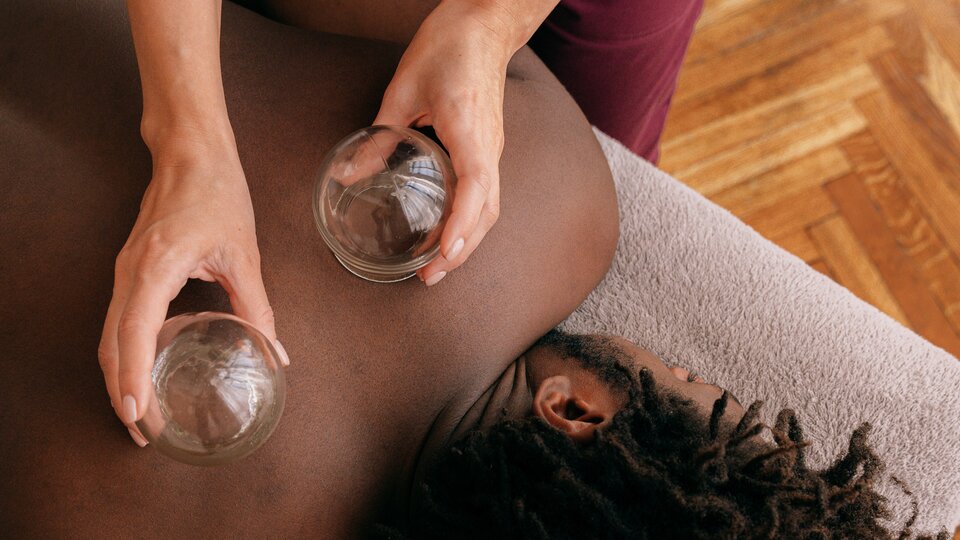Cupping is an ancient healing practice found in Chinese, Egyptian and Middle Eastern cultures (1). However, its use has been steadily increasing throughout the fitness community as a recovery tool. Cupping therapy is a treatment where an individual applies pressurized cups to the skin through heat or suction to try to increase peripheral blood flow, reduce pain, detoxify the body, eliminate migraines, treat acne, lower cholesterol, and enhance immunity (1).
There are two main types of cupping: dry and wet. The first step of dry and wet cupping are the same. The therapist will place a flammable substance such as alcohol into the cup and light it on fire. As the fire goes out, the therapist will place the cup on your skin to create a vacuum. The cup stays on for three to five minutes in order to pull blood to the skin’s surface. In wet cupping, the therapist will continue treatment by removing the cup and applying superficial cuts or a needle puncture to the affected skin. The therapist will apply a second round of suction in order to draw out a small quantity of blood (2).
Mainstream doctors practicing ‘western style’ medicine will state that there is no definitive scientific research proving the efficacy of cupping nor is there any identifiable mechanism for its benefits. While traditional ‘eastern style’ medicine practitioners will cite the over 2,000 years of practical application and its holistic approach to wellness (2).
Perhaps cupping can be explained through a global effect of some or all of the following proposed mechanisms, but more research needs to be conducted for definitive proof (1). Immune Modulation theory suggests that changing the skin’s microenvironment modulates the biological signals to activate the neuroendocrine immune system (3). Genetic theory suggests that mechanical and oxidative stress on the skin activates and inhibits gene expression (4). Pain-Gate theory suggests that causing pain in one area can relieve pain in different areas (2). Nitric Oxide theory suggests cupping releases NO to promote vasodilation and blood flow mediation (2). In wet cupping therapy, the superficial scarifications could activate a cascading wound-healing effect (2). Perhaps, the placebo theory can explain the benefits of cupping since expectation of beneficial effects can have real measurable results.
There have been clinical studies on the effects of cupping. However, it is difficult to perform a high-quality scientific study, because it is nearly impossible to conduct a double blind placebo-controlled trial in which neither the patient nor the researcher knows which treatment (real or placebo) has been given to a study subject (5).
In a review of 135 randomized clinical trials, the authors found that most of the studies on cupping had low methodological scientific rigor. The majority of the studies involved curing acne and skin breakouts. 85% of the studies had a high likelihood of bias. Many of these studies combined multiple treatments instead of focusing on cupping by itself (6). In another examination of 75 randomized control trials involving the use of cupping to alleviate neck pain, the authors found that cupping did have some meaningful benefits in mitigating short term pain similar to acupuncture (7). A small but well designed study found that wet cupping therapy was able to remove oxidants and decrease oxidative stress and had similar benefits to giving blood (8). The scientific literature is currently inconclusive on the mechanisms and efficacy of cupping as a stand alone treatment.
While cupping therapy is relatively safe with rare side effects. It can cause skin discolorations lasting for several days. It can also cause uncomfortable pinching from the suction. In wet cupping, there can even be scar formations. Other adverse effects include headache, dizziness, muscle tension, nausea, skin infection, or pain at the cupping site (1).
Cupping is a controversial topic yet it is an inexpensive, noninvasive, and generally low-risk therapy that can easily be added to your arsenal of health promoting treatments, especially when combined with acupuncture, acupressure, and/or massage. However, if you are unsure about its scientific efficacy, then you should wait until further research has determined a more concrete answer before undergoing the therapy yourself.
Works Cited
- https://www.sciencedirect.com/science/article/pii/S2005290117302042
- https://www.ncbi.nlm.nih.gov/pmc/articles/PMC6435947/
- https://www.sciencedirect.com/science/article/abs/pii/S1744388117301585
- https://f1000research.com/slides/6-1684
- https://www.health.harvard.edu/blog/what-exactly-is-cupping-2016093010402
- https://www.ncbi.nlm.nih.gov/pmc/articles/PMC3289625/
- https://pubmed.ncbi.nlm.nih.gov/25710765/
- https://pubmed.ncbi.nlm.nih.gov/25453524/

